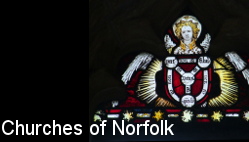
home I index I introductions I e-mail I about this site
St Margaret, Little Dunham
Follow these journeys as they happen at Last Of England Twitter.
| St
Margaret, Little Dunham Little
Dunham is a tiny village, but in any case its church sits
away from it, off of the road to Sporle. The churchyard
is hemmed by pleasantly arboured sheep meadows which in
early spring are filled with birdsong and the
high-pitched nagging of lambs staggering and bullying
their mothers. In the 1980s Mortlock described the
setting as serene, and so it remains today. The
church is largely an Early English rebuilding of the 13th
Century, with a tower added over several decades in the
middle of the 15th Century. The very top of the tower
appears to be a repair job, perhaps of the 18th Century.
But it is the ambience of the Early English period which
greets you as you step inside, one of elegance and
simplicity. A rustic interior, with the sense of a
touchstone church, the accumulation of the ages, although
in fact most of the furnishings are from the 19th Century
restoration, as are the floor tiles and the elegant
crucifixion in the glass of the east window which is
presumably by the O'Connors. But perhaps that is why the
interior is so pleasing, for it gives the sense of a
rural community just out of sight, just beyond the
horizon of our own time. Simon Knott, October 2022 Follow these journeys as they happen at Last Of England Twitter. |
|
|||||||||||||||||||||||||||||||||||||||||||||||||||||||
home I index I latest I introductions I e-mail I about
this site I glossary
Norwich I ruined churches I desktop backgrounds I round tower churches
links I small
print I www.simonknott.co.uk I www.suffolkchurches.co.uk